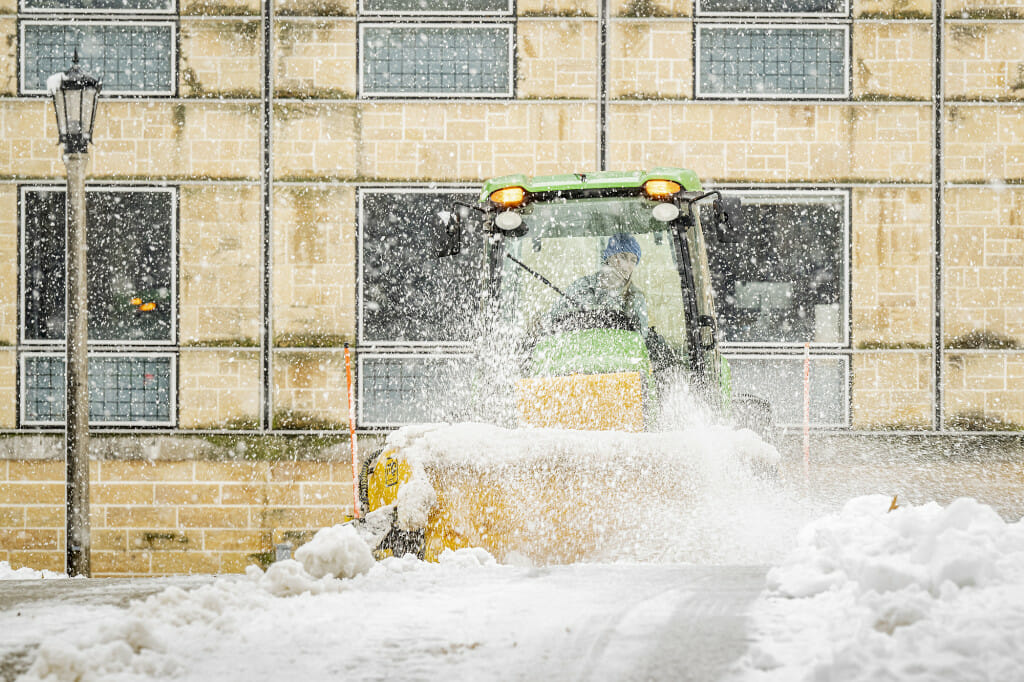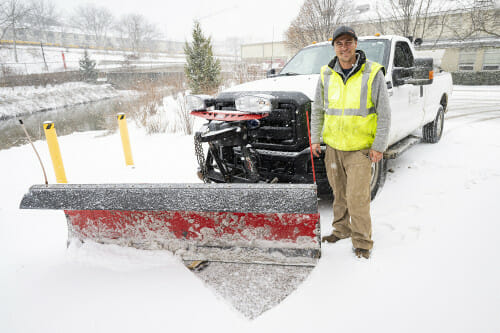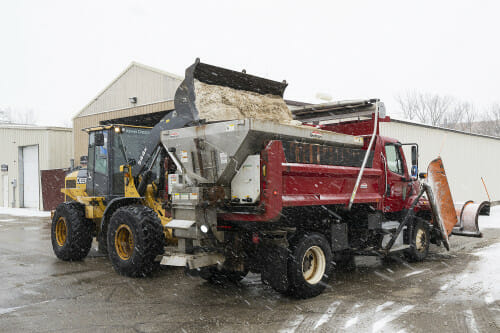Ride along with facilities crews as they take on winter weather

A member of the UW grounds crew drives a tractor with a snow brush to clear sidewalks for safe passage on Bascom Hill during a snow storm on Feb. 9, 2023. Facilities Planning & Management operators meet for prep sessions on weather events before going out. They talk about what kind of precipitation is expected, how much is coming and what kind of sand mixture to use to mitigate the potential for slippery surfaces. Photo: Bryce Richter
On cold, snowy mornings when many dread scraping the ice off windshields or making the trek to a frigid bus stop, University of Wisconsin–Madison’s Facilities Planning & Management employees are already hours into their shifts, making sure that students, staff and visitors can navigate the wintry conditions as safely as possible.
When a snowstorm hit southern Wisconsin in mid-February, Anton Slobounov was on campus at 6 a.m., preparing to plow his west campus route, which takes him by Brittingham House and UW Health. Slobounov, a facilities technician III with FP&M, has been with the division for five years.

Anton Slobounov, grounds crew member at the University of Wisconsin—Madison, covered a west campus snow removal route during a winter storm in mid-February. Drivers like Slobounov practice their assigned plowing routes before the first snow, so they know of possible hazards in their route. Photo: Bryce Richter

Bob Bonner, grounds crew member at the University of Wisconsin–Madison, operates a snow plow near UW Health University Hospital. Photo: Bryce Richter
Inside the snowplow’s cab, Slobounov deftly raises and angles his plow to push snow around while using another control to drop a sand mix behind the truck. Rear-mounted cameras show him how much mix he’s laying down.
FP&M has long been focused on reducing salt use, wherever and whenever possible. Slobounov and his fellow salt spreading machine operators are certified in salt usage by the City of Madison and take an annual salt use training.
When out clearing ice and snow, Slobounov and the rest of the FP&M crew track how much salt they use. FP&M reports the information as part of the stormwater permitting process.
“We’re definitely very conscious of the salt we use,” Slobounov says. “We’re extremely fortunate to have a campus on the water. I use the lakes with my family. We are committed to making sure the campus is safe while at the same time protecting the lakes while we do it.”
Ready to act
“FP&M staff works at all hours and during all seasons to keep campus safe,” says Ellen Agnew, Interim Director of Services. “Every year, I am impressed with the dedication in planning, executing and improving weather event responses.”
The operators meet for prep sessions on weather events before going out. They talk about what kind of precipitation is expected, how much is coming and what kind of sand mixture to use to mitigate the potential for slippery surfaces.
Drivers like Slobounov practice their assigned plowing routes before the first snow so they know of possible hazards on their route. It’s skillful work, requiring them to negotiate steep inclines and downhills, sharp turns and jutting curbs.

A member of the UW grounds crew drives a tractor with a snow brush to clear sidewalks for safe passage on Bascom Hill during a snow storm on Feb. 9, 2023. As soon as the snow starts to stick, crews hit the streets and sidewalks with plows, broom tractors and snowblowers to make navigating campus by car, bike or foot as safe as they can. Photo: Bryce Richter

Pedestrians walk along a recently cleared sidewalk on Bascom Hill. Photo: Bryce Richter
As soon as the snow starts to stick, crews hit the streets and sidewalks with plows, broom tractors and snowblowers to make navigating campus by car, bike or foot as safe as possible.
Part of those safety measures includes clearing parking lots and sidewalks before students and daytime staff arrive on campus.
“We use machines to clear the majority of the snow, and re-plow and re-broom throughout the (weather) event,” Slobounov says. “The timing is definitely important.”
Maximizing the use of the equipment to remove the snow minimizes the need for other mitigation efforts like salt.
The salt and sand equation
Planning for winter weather and equipment preparation typically begins in August, but thinking about how snow impacts campus is a year-round concern.
Staff train on using the minimum effective amount of salt. (One coffee mug of salt is typically sufficient for a 20-foot driveway or 10 sidewalk squares, and one application is typically enough). There are exceptions, like when operators intend to distribute bulk salt. If excess salt is released through machine error, operators will go back and clean it up.

Bob Bonner, grounds crew member at the University of Wisconsin–Madison, fills a snow plow with a sand and salt mixture during a snow storm on Feb. 16, 2023. Staff train on using the minimum effective amount of salt. Photo: Bryce Richter
For colder temperatures, sand is most effective for providing traction under feet and tires. FP&M staff will typically focus salt use on stairs, building entries and hills along with high-traffic pedestrian paths. Around campus, FP&M staff will close off lesser-used stairs and sidewalks to avoid the need for salt.

A closed sign and chain blocks off a section of stair steps between Ingraham Hall and Van Vleck Hall to reduce the need for snow removal and salt use during a snow storm on Feb. 9, 2023. Photo: Bryce Richter

Scott Schuette, a metal recycling specialist with Facilities Planning & Management, spreads a sand mixture on the sidewalks and stairs steps for safe passage at the base of Bascom Hill and Park Street. Photo: Bryce Richter
Additionally, FP&M partners with academic programs to research the environmental impact of salt. One Nelson Institute Water Resources Management Master’s program cohort used UW–Madison as a case study to improve local water quality through optimizing salt use. Their project was titled Blueprint for Salt Sustainability on the UW–Madison Campus. Several recommendations from this program have been adopted, such as continued staff training and updated signage.
‘An organized dance’
The strategy on the day of a weather event is to act early — and often. When conditions allow, staff will spread salt brine — which makes snow easier to remove and prevents ice buildup — to prepare the surfaces before the snow even begins. The brine is recycled from a campus heating plant, where it’s first used to flush out water softeners.
Campus has 60 bus stops, 60 miles of sidewalks, 13 miles of roads and 100 parking lots spread over 938 acres. FP&M divides that terrain into designated sections for snow removal. Crews work alongside staff from Housing, Athletics, Rec Well and the Wisconsin Union to clear each section.

A worker uses a snow blower to clear sidewalks for safe passage near the Humanities Building. Photo: Bryce Richter

Scott Schuette, a metal recycling specialist with Facilities Planning & Management, uses a snow shovel to clear sidewalks and steps. Photo: Bryce Richter
The university shares a number of boundaries with various entities, including the City of Madison. These include some Madison Metro routes, so UW–Madison often works with Madison Metro to keep bus routes clear. The university also works in tandem with the local communities that border campus, which sometimes includes spaces often mistaken for campus, such as State Street Mall (the corridor between the Historical Society building and Humanities).
Roadways, bus routes, high-traffic pedestrian areas, accessible routes and ramps into parking garages are given the top priority. As much as possible, FP&M schedules the work around class breaks and other high-traffic times on campus. Two-way radios keep the operators in touch with dispatch at the department, to help them stay on top of trouble areas.
Other snow removal begins after midnight, often starting as early as 1 a.m. Once equipment routes are finished, the shovels come out for the fine work around stairs and building entrances. Ultimately, the goal is to clear all bike paths, walkways and roads within 24 hours.
“It’s an organized dance,” Slobounov says. “The more events you’re in, the more you know what to expect.”
For problem areas on campus in need of plowing or shoveling attention, please contact UW Physical Plant (Grounds) at ppcustomerservice@fpm.wisc.edu or (608) 263-3333.



